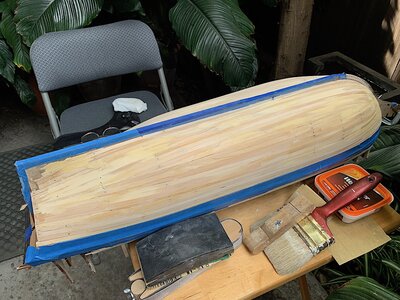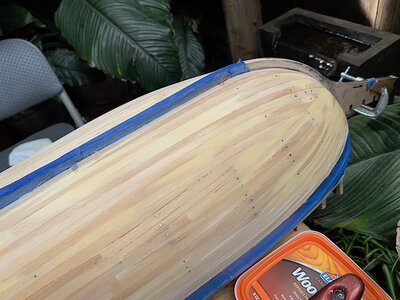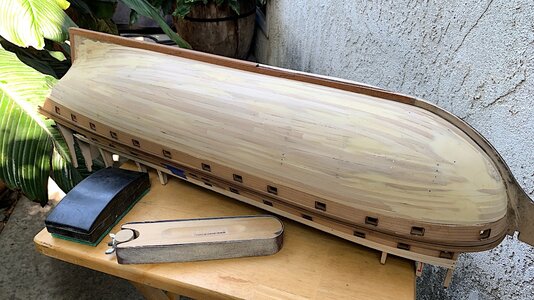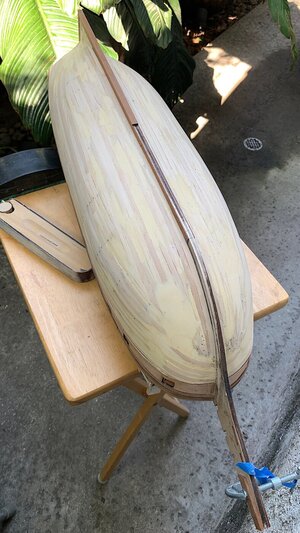-

Win a Free Custom Engraved Brass Coin!!!
As a way to introduce our brass coins to the community, we will raffle off a free coin during the month of August. Follow link ABOVE for instructions for entering.
-

PRE-ORDER SHIPS IN SCALE TODAY!
The beloved Ships in Scale Magazine is back and charting a new course for 2026!
Discover new skills, new techniques, and new inspirations in every issue.
NOTE THAT OUR FIRST ISSUE WILL BE JAN/FEB 2026
You are using an out of date browser. It may not display this or other websites correctly.
You should upgrade or use an alternative browser.
You should upgrade or use an alternative browser.
Sovereign of the Seas - Sergal 1:78 (with hopefully many added details)
I knew that Amati also had a Sovereign kit, and that it is no longer being produced. I did not know that Amati currently still markets the 100s of their decorative bits available in a complete set (plans are also available as well as the flag sheet).
Kurt (DARIVS ARCHITECTVS) mentioned that he, in fact, has the decorative set and was praising the quality of casting details, suggesting that they might be the best that he has ever come across.
I resisted spending more for this project, but then went ahead. Woa!! Indeed – here are just few images so that members have a sense of how “perfect” these castings really are.
Yes, the Amati and the Sergal kits are different scales, but these Amati castings, as appropriate, will also become part of my current project. Thanks for the head’s up Kurt.
PS: images taken under 5K LED's so warmth of the metal is a bit "cold" looking - these are so perfect...
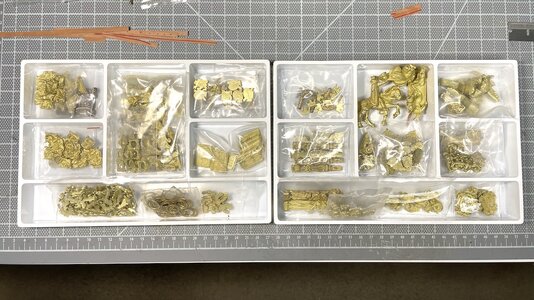
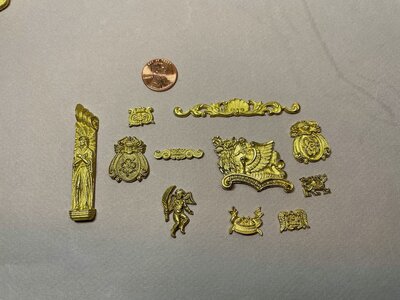
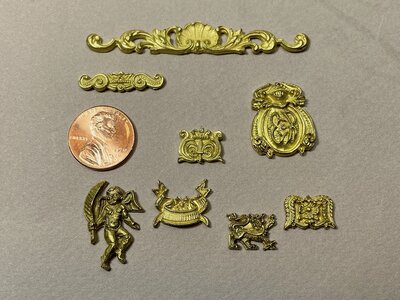
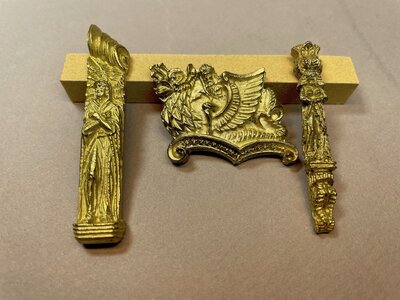
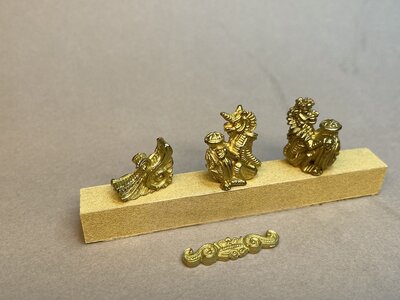
Kurt (DARIVS ARCHITECTVS) mentioned that he, in fact, has the decorative set and was praising the quality of casting details, suggesting that they might be the best that he has ever come across.
I resisted spending more for this project, but then went ahead. Woa!! Indeed – here are just few images so that members have a sense of how “perfect” these castings really are.
Yes, the Amati and the Sergal kits are different scales, but these Amati castings, as appropriate, will also become part of my current project. Thanks for the head’s up Kurt.
PS: images taken under 5K LED's so warmth of the metal is a bit "cold" looking - these are so perfect...





No problem oldflyer. You CAN get the casting parts individually from Cornwall Boats and a few other Amati dealers, IF YOU HAVE TO. The style of the Amati decorations is quite different than other decoration sets. Lots of fine lines on the castings, not the current generation lumpy castings Mantua (Sergal) is making these days. I have yet to find a castings set that copies the correct shapes and figures of the early version of SotS shown in Payne's prints. As for commercial cast decorations sets, it appears we have to sacrifice a lot of accuracy or make our own carvings, which I am not set up to do. Quite disappointing. I don't know yet if the Amati castings will fit on the DeAgostini hull due to differences in scale. In order to use the expensive Amati set, I may have to abandon the DeAgostini kit and go full scratch build. Not yet decided. Research needs to be done to decide if the Deagostini or Amati hull shapes are more accurate too. In the meantime, completion of La Couronne needs to be done.I knew that Amati also had a Sovereign kit, and that it is no longer being produced. I did not know that Amati currently still markets the 100s of their decorative bits available in a complete set (plans are also available as well as the flag sheet).
Kurt (DARIVS ARCHITECTVS) mentioned that he, in fact, has the decorative set and was praising the quality of casting details, suggesting that they might be the best that he has ever come across.
I resisted spending more for this project, but then went ahead. Woa!! Indeed – here are just few images so that members have a sense of how “perfect” these castings really are.
Yes, the Amati and the Sergal kits are different scales, but these Amati castings, as appropriate, will also become part of my current project. Thanks for the head’s up Kurt.
PS: images taken under 5K LED's so warmth of the metal is a bit "cold" looking - these are so perfect...
Last edited:
I really liked reading your expose on the shipboard guns, shot, and powder manufacture as you may guess from my own current involvement with my firing scale cannon shooting 0.27 inch, 30 grain, lead ball shot with 15 grains of FFFg black powder in the typical muzzle loader manner. Still experimenting with range and bolsters' combinations for elevation control. Thanks, PT-2More useful information to help calculate gun barrel size. The guns are described by weight. When you combine that information with other sources describing the shape of a particular gun, you can guess as to its length and buy model cannon barrels that are close to matching. Save this for your notes. I forgot where I found this on the internet:
Sovereign Armaments
When she was first fitted out, the guns of the Sovereign of the Seas were supplied by John Browne, the son of a gunfounding family. His father, Thomas Browne, was the Founder of Iron Ordnance to Elizabeth I and James I. Although not apprenticed in iron making, John took over his father’s patents in 1615 when he was appointed one of the King’s Founder of Iron Ordnance afloat and ashore with a wage of eight pence – 7½p, worth £7.20 today – a day. With ironworks in Brenchley and Horsmonden in Kent, he was aided by a decree in 1619 that confined gunfounding to Kent and Sussex, where he also had interests.
In the 1620s, Browne developed a new cannon known as the drake. Weighing a third less than earlier cannon firing the same weight of shot, these allowed ships to be more heavily armed. Originally a Dutch design, the drake had a shorter barrel that conventional cannon with a bore that was wider at the muzzle than at the back of the chamber. It used only two-thirds of the powder of its conventional counterpart and was easier to handle when firing repeatedly. While the velocity and range suffered, at close quarters it was more devastating than a conventional piece.
Browne received a reward of £200 – £19,000 today – for the introduction of the dake. But in 1635 he had to pay Charles I £12,000 – over £1 million today – for a patent allowing him to make, sell and transport ordinance and shot. Browne was selling guns to the Dutch and Spanish, as well as the crown, and Charles effectively became a partner in his export business. This was tightly regulated. All ordnance could only be landed at, or shipped from, the wharf at the Tower of London. Proving was done in Ratcliff Fields, Stepney, and all sales took place in East Smithfield. Guns also had to carry at least two letters of the founder’s name, the year of manufacture and the weight of the piece.
His arrangement with the king also brought Browne honours. He was granted a coat of arms that consisted of “Gules a passant and a Chief Or” – “Gules” is red, the “Chief” is the top third of the shield and it was “Or” or gold. A Griffin is half-lion, half-eagle and “passant” means that walking, with its face in profile.
His crest was even more elaborate: “Upon a Helm with a Wreath Or and Gules. A Falcon wings inverted and addorsed proper armed legged and belled Or preying upon a Mallard’s Wing Proper, Mantled Gules doubled Argent.”
In 1637, Browne paid out another £1,000 to adapt his foundry to cast the guns for the Sovereign of the Seas. Though the iron works is long gone, the Furnace Pond came still be seen outside the village of Horsmonden. The works were well sited. The River Medway was handy to transport the guns and the area was rich in timber for fuel. However, in 1637, the nearby village of Cranbrook made a complaint that John Browne had purloined most of their woodlands to the detriment of their craft of weaving. But Browne position was unassailable and he was appointed the King’s Gunfounder in 1640.
Browne made the guns for the Sovereign of the Seas by the lost-wax process. He made a full-size model of the piece in wood, including all the decoration and annotation – and the trunnions on either side that rested on the gun carriage. These were placed slightly behind the centre of gravity so that the gun would naturally elevate.
The wooden model was then used to made a mould, which was used to cast a wax replica. This is then smeared with lard or grease and seared with a clay paste mixed with hair, flax and horse droppings. When turned over a fire, the clay harden, while the wax drained away. The shell was then strengthened by iron rods and thickened with the addition of more clay.
A core was made by a similar clay mixture smeared over an iron spindle bound with rope. The outer surface was then smoothed, dried and burnished to the diameter given by a template. The shell was placed in a pit with the muzzle end upwards and the core was inserted. Then molten metal was poured in. Once it had solidified and cooled, the mould was broken and removed. The outside was smoothed with a chisel on a lathe, the inside reamed, and the powder hole or vent drilled.
The guns were seated in a carriage. The sides were usually made of elm which was resistant to splintering if struck by flying debris. The cross beams were oak. Because of the narrowing diameter of the gun, the sides – or cheeks – of the gun carriage sloped towards each other at the fore end. The carriage was strengthened with iron straps. The small carriage wheels were also elm and mounted on an iron axle.
The Sovereign of the Seas had 118 gun ports and only 102 guns. The shape of the bow meant that the foremost gun ports on the lower gun deck were blocked by the anchor cable. Consequently, the fore chase – the guns facing forward – occupied the next ports. There were two demi-cannon drakes – one port, one starboard – some 11.5 feet long (3.5m), weighing together five tons (4,536kg). They had a bore of 6.4 to 6.75 inches (16.2–17.1cm) and fired a shot weighing 32 to 36 pounds (14.5–16.3kg), using around ten pounds of gunpowder.
In the third ports from the bow, there were two 11-foot (3.4m) demi-cannon drakes weighing, together, 4.3 tons (3,901kg). Behind them were twenty VII drakes, nine feet long, and weighing in all 45.7 tons (41,458kg). In the third port from the stern were two more 11-foot (3.4m) demi-cannon drakes weighing, together, 4.3 tons (3.901kg). The last two ports on either side were occupied by the stern chase – four 10.5-foot (3.2m) demi-cannon drakes weighing a total of 11.4 tons (10,342kg).
The middle gun deck had heavy fortified culverins – that is, guns short for their bore – fore and aft. There were two 11.5-foot (3.5m) pieces, weighing 4.8 tons (4,354kg), in the fore chase; four 11.5-foot (3.5m) pieces, weighing 10.2 tons (9,253kg), in the stern chase. Immediately behind the fore chase were two demi-culverin drakes, eight to nine foot (2.4–2.7m) long, weighing some 1.9 tons (1,724kg). Then came twenty-two 9.5-foot (2.9m) culverin drakes weighing a total of 30.4 tons (27,578kg).
On the upper gun deck there were two 10-foot (3m) fortified demi-culverins in the fore chase and two in the stern chase, both pairs weighing 2.8 tons (2,540kg). Between them there were twenty-two demi-culverin drakes, eight to nine feet (2.4–2.7m) long, weighing over 21 tons (19,000kg) in total.
There were eight-to-nine-foot (2.4–2.7m) demi-culverin drakes weighing 7.7 tons (6,985kg) in the forecastle; another six weighing 5.7 tons (5,170kg) on the half-deck. The quarter-deck carried two six-foot demi-culverin drake cutts – a cutt, again, being a shorter version of a gun – weighing 16 hundredweight (726kg). Then there were another two six-foot culverin cutts, weighing 1.3 tons (1,179kg), aft of the forecastle bulkhead. In all, the Sovereign of the Seas carried 155.9 tons (141,430kg) of guns – and that did not include the weight of the gun carriages. Altogether they cost £26,441 13s 6d – or £2,268,695.72 in today’s money – including £3 (£257.50) per piece to have the Tudor rose, a crown and the motto: “Carolvs Edgari sceptrvm aqvarum” – “Charles has established Edgar’s sceptre of the waters” – engraved on them. The gun carriages, made by Matthew Banks, Master Carpenter for the Office of Ordinance, cost another £558 11s 8d – £47,926.45 today.
The shot was made from cast iron or lead cast around a stone core – five parts lead to one part stone. This ratio made the lead-and-stone shot roughly the same weight as a cast-iron cannon ball of the same diameter.
The shot was made slightly smaller than the diameter of the barrel. This difference is known as the windage. During the sixteenth century the windage was kept at a constant 0.25 inches (0.635cm). But in the seventeenth century the bore divided by the diameter of the shot was fixed at 20:21 for English pieces or 27/26 for French pieces.
The gunpowder, or black powder, used as a propellant was a mixture of charcoal, sulphur and saltpetre – that is, potassium nitrate. It was manufactured under licence at Ospringe, near Faversham in Kent. The charcoal was produced locally, while the sulphur came from Sicily and Italy, and the saltpetre from Italy and India. The mills were on a tidal creek, making it easy to bring in the imported ingredient. Running water in the creek also supplied the power to grind the powder. Then it could be transported by boat to London, the arsenals along the Medway and the Channel ports.
Saltpetre was also produced locally from bird droppings. In 1634, Francis Vincent of Canterbury was appointed official “saltpetre man” for Kent, Sussex and Surrey, required to produce six hundredweights (272kg) a week. His main source was dovecotes in Kent. The soil from the floor was mixed with water and filtered through clean sand. Pure saltpetre was then crystallized out of the solution.
Gunpowder was made in Ospringe from 1560 to 1925. The mills there were owned by Thomas Judd who produced two tons of gunpowder a week in 1653. More was made in Chilworth in Surrey from 1635 to 1920.
While the powder was being milled using a large metal mortar and pestles, it was dampened by fresh water, vinegar or brandy to reduce the chance of spontaneous combustion. Finely milled gunpowder was called serpentine and used in the vent to ignite the main charge, or in small arms. The rest of the gunpowder was corned – dampened with water it was pressed through thick parchment with small holes in it to produce grains of a uniform size. These would not be compressed when tamped in the barrel. If the powder was too tightly packed, it excluded the air and, without oxygen, the gunpowder would not ignite. Corned gunpowder produced greater power, resulting in a higher muzzle velocity and greater range.
The powder was supplied in wooden barrels with copper, rather than iron, bands. This reduced the chances of producing a spark. Vinegar or brandy was also added to powder to prevent the powder deteriorating if seawater soaked into the wood.
The Sovereign of the Seas carried 330 kegs of powder, along with 2,850 round shot, 720 double-headed shot, 300 muskets, twenty blunderbusses, 200 pikes and 100 hatchets.
It is not entirely clear what happened to the cannon after the Sovereign of the Seas was destroyed. One demi-culverin drake sat at the northwest corner of Horseguards Parade in London for many years. In 1917, it was in store at the Rotunda, Woolwich, then it was moved to Chatham Dockyard. Since 2000 it has been on display at the Royal Artillery Museum in Woolwich. Engraved on it is: “JOHN BROWNE MADE THIS PEECE ANO, 1638” – along with the rose, crown and motto.
In the Royal Armouries in Leeds, there is a four-pounder with the Tudor rose and the letters C.R. – Carolus Rex – inscribed on it, along with the words: “CAST IN THE PRESENCE OF HIS MAJ OCTO THE FIFTH 1638, MOVNTIOY EARLE OF NEWPORT M GENERALL OF THE ORDNANCE. JOHN BROWNE MADE THIS PEECE.” Thought to be one of the Sovereign of the Seas’ original guns, it also saw service at the dockyards in Deptford in the Dutch attack of 1667.
The Royal Armouries has another piece with similar markings which was exhibited at the Royal Naval Exhibition in Chelsea in 1891. Until 1930 it was at the Rotunda Museum in Woolwich before being transferred to the Royal Armouries. However, neither of these two guns is thought to have been part of the Sovereign of the Seas’ main armament. Rather they may have been signal guns.
I knew that Amati also had a Sovereign kit, and that it is no longer being produced. I did not know that Amati currently still markets the 100s of their decorative bits available in a complete set (plans are also available as well as the flag sheet).
Kurt (DARIVS ARCHITECTVS) mentioned that he, in fact, has the decorative set and was praising the quality of casting details, suggesting that they might be the best that he has ever come across.
I resisted spending more for this project, but then went ahead. Woa!! Indeed – here are just few images so that members have a sense of how “perfect” these castings really are.
Yes, the Amati and the Sergal kits are different scales, but these Amati castings, as appropriate, will also become part of my current project. Thanks for the head’s up Kurt.
PS: images taken under 5K LED's so warmth of the metal is a bit "cold" looking - these are so perfect...
View attachment 188468View attachment 188469View attachment 188470View attachment 188471View attachment 188472
Yes, the Amati decorations are way better than the Sergal ones. Completely different category.
János
Regarding this ship’s numerous ornamentations, as Kurt suggested sculpturing handmade images would arguably result in a more accurate look of the early example of the Sovereign. That said short of brilliant artists such a Janos, I could not even consider the idea let alone a “Lagos” interpretation of these hundreds of pieces. It would also probably also require gold foiling the bits as well hmmmm? And as Kurt posted, his skill set not quite there. Sculpting really is an art in-and-of-itself. 
I would not have purchased individual Amati bits, but just stayed with Sergal’s solid bronze bits from the vintage kit. Now with the 412 pieces supplied from Amati more options are available. As far as scale differences of the larger pieces (Amati) they are smaller (cannon opening trims, hull half doors etc.) so fitting some to this Sergal may not work. 1/100 to 1/78 – to be determined much later on.
=========================
Minor update:
Decided against increasing the bow stem tip to run above the beakshead deck. Instead thought, as I have seen in museum images of this ship, add a decorative cap cover instead. Here are a few images. And one more image of what Amati included.
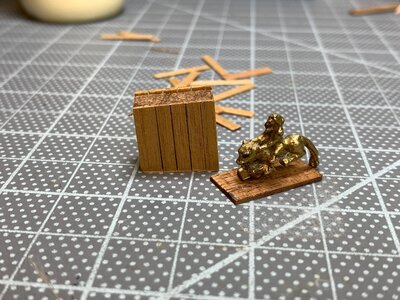
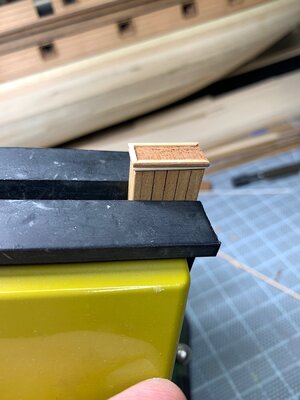
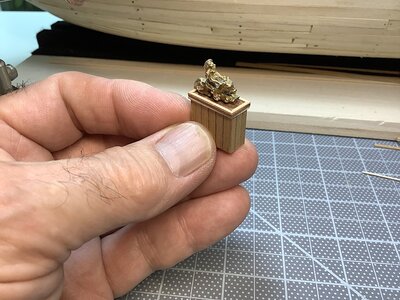
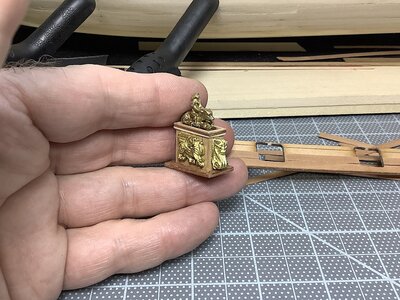
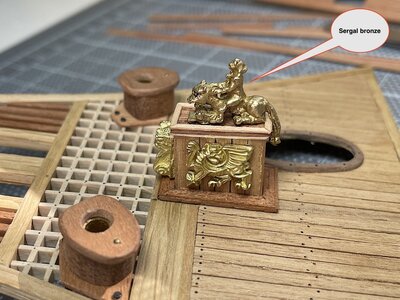
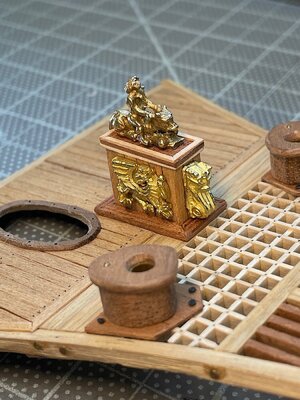
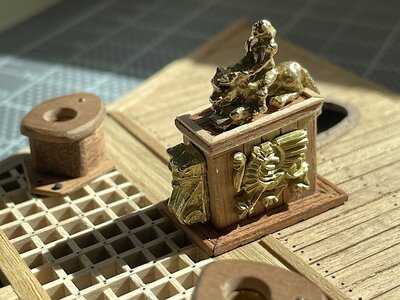
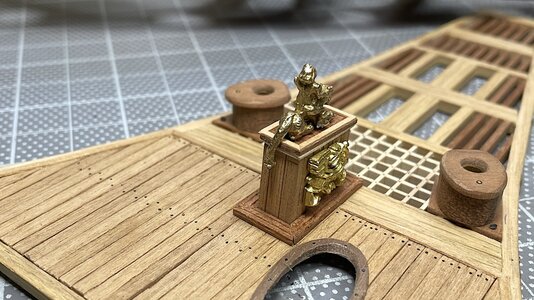
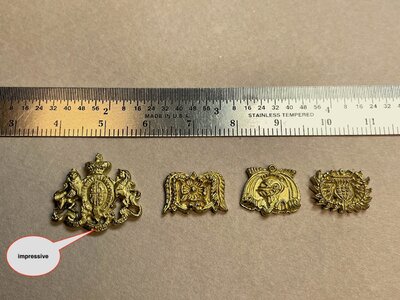
Thanks for your comments

I would not have purchased individual Amati bits, but just stayed with Sergal’s solid bronze bits from the vintage kit. Now with the 412 pieces supplied from Amati more options are available. As far as scale differences of the larger pieces (Amati) they are smaller (cannon opening trims, hull half doors etc.) so fitting some to this Sergal may not work. 1/100 to 1/78 – to be determined much later on.
=========================
Minor update:
Decided against increasing the bow stem tip to run above the beakshead deck. Instead thought, as I have seen in museum images of this ship, add a decorative cap cover instead. Here are a few images. And one more image of what Amati included.









Thanks for your comments
Those are very precise castings. I wonder about the process with what appear to be almost or are undercuts. . . must be some type of flexible mold for resin and possibly then given some type of spray gilding. If solid metal that raises a good question. I don't know if 3-D printing could be as precise. Just wondering and in amazement!!! PT-2I knew that Amati also had a Sovereign kit, and that it is no longer being produced. I did not know that Amati currently still markets the 100s of their decorative bits available in a complete set (plans are also available as well as the flag sheet).
Kurt (DARIVS ARCHITECTVS) mentioned that he, in fact, has the decorative set and was praising the quality of casting details, suggesting that they might be the best that he has ever come across.
I resisted spending more for this project, but then went ahead. Woa!! Indeed – here are just few images so that members have a sense of how “perfect” these castings really are.
Yes, the Amati and the Sergal kits are different scales, but these Amati castings, as appropriate, will also become part of my current project. Thanks for the head’s up Kurt.
PS: images taken under 5K LED's so warmth of the metal is a bit "cold" looking - these are so perfect...
View attachment 188468View attachment 188469View attachment 188470View attachment 188471View attachment 188472
Your application of the decorations to the deck furniture is really nice. Well done and if continued will result in a beautifully presented ship. PT-2Regarding this ship’s numerous ornamentations, as Kurt suggested sculpturing handmade images would arguably result in a more accurate look of the early example of the Sovereign. That said short of brilliant artists such a Janos, I could not even consider the idea let alone a “Lagos” interpretation of these hundreds of pieces. It would also probably also require gold foiling the bits as well hmmmm? And as Kurt posted, his skill set not quite there. Sculpting really is an art in-and-of-itself.
I would not have purchased individual Amati bits, but just stayed with Sergal’s solid bronze bits from the vintage kit. Now with the 412 pieces supplied from Amati more options are available. As far as scale differences of the larger pieces (Amati) they are smaller (cannon opening trims, hull half doors etc.) so fitting some to this Sergal may not work. 1/100 to 1/78 – to be determined much later on.
=========================
Minor update:
Decided against increasing the bow stem tip to run above the beakshead deck. Instead thought, as I have seen in museum images of this ship, add a decorative cap cover instead. Here are a few images. And one more image of what Amati included.
View attachment 188688View attachment 188689View attachment 188690View attachment 188691View attachment 188692View attachment 188693View attachment 188694View attachment 188695View attachment 188696
Thanks for your comments
PT-2 thanks for your interest and nice comments - PS 3D printing will be the future of this hobby - as needed - for now just finishing up first hull planking (will update) - then onto over-planking kit main deck with Pear wood strips.
Member and guests - Thanks for all of your likes or just looking in.
Member and guests - Thanks for all of your likes or just looking in.
Last edited:
Nice tightly placed planking. PT-2 (Rich)Minor update.
Mostly finished the -not so much fun- first hull sanding. Can now focus the hull stern detailing -
View attachment 192183View attachment 192184View attachment 192185View attachment 192186
Hi John, I notice that you live on the west coast, hopefully not in a high humidity area. I live in a high humidity area and on a model I made a few years ago there are brown spots appearing, through the paint, where the so called brass nails are inserted. I would suggest coating the hull with some type of rust inhibitor in the paint/undercoat, moisture will find a way of getting into the timber.
On my SoS (DeAgostini subscription build) all the metal pieces are white metal and are very well detailed but with a medium applied and gilding they may lose some of that detail.
On my SoS (DeAgostini subscription build) all the metal pieces are white metal and are very well detailed but with a medium applied and gilding they may lose some of that detail.
that humidity and metal discoloration is a good storm warning to have run up. PT-2 (Rich)Hi John, I notice that you live on the west coast, hopefully not in a high humidity area. I live in a high humidity area and on a model I made a few years ago there are brown spots appearing, through the paint, where the so called brass nails are inserted. I would suggest coating the hull with some type of rust inhibitor in the paint/undercoat, moisture will find a way of getting into the timber.
On my SoS (DeAgostini subscription build) all the metal pieces are white metal and are very well detailed but with a medium applied and gilding they may lose some of that detail.
Your first planking is looking very good - well prepared to have a very good basis for the second and final planking 

Thanks mates -
Eric/PT-2 - thanks for the advice - the humidity in my area is very moderate - nothing like the East coast of the USA. typically 50-60% with Mediterranean weather patterns.
Uwe - thanks for your kind words.
Eric/PT-2 - thanks for the advice - the humidity in my area is very moderate - nothing like the East coast of the USA. typically 50-60% with Mediterranean weather patterns.
Uwe - thanks for your kind words.
Along with first planking worked on the lower transom, sternpost, keel as well as importantly adding stern cannon framings and dummy carriages.
Yes –as we all are aware of the tucked stern controversy; some historians (a few) have questioned the rounded tuck –most have used Pett’s painting as “the” reference”. I chose to build a modified square tuck – right or wrong – In any case this current project will, however modified, not represent amazing much more accurate scratch built examples. Given the still existing controversies, I won’t labor over my errors so far, and certainly those coming up. That said, here are some images so far.
As always thanks so much for dropping by.
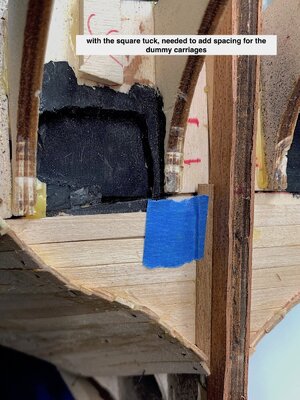
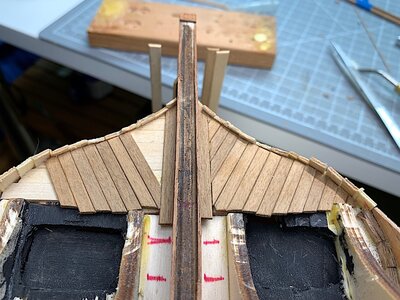
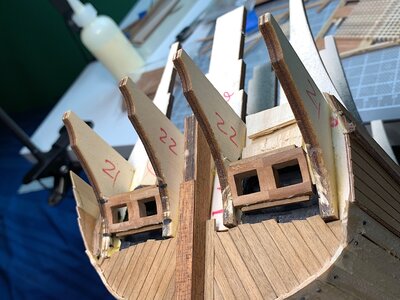
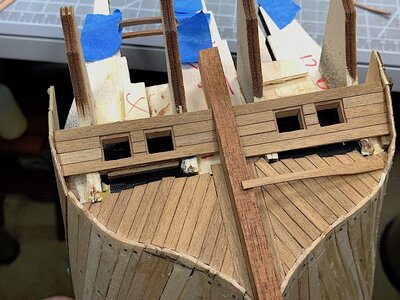
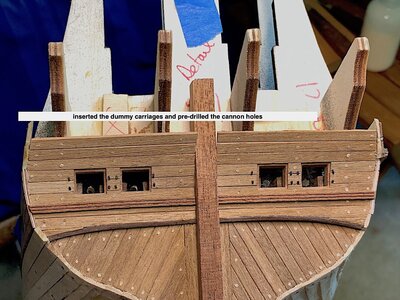
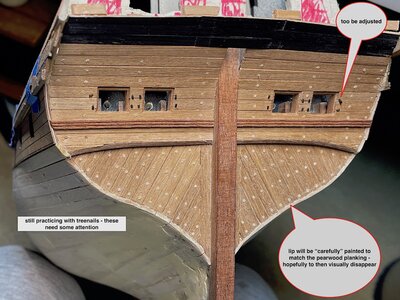
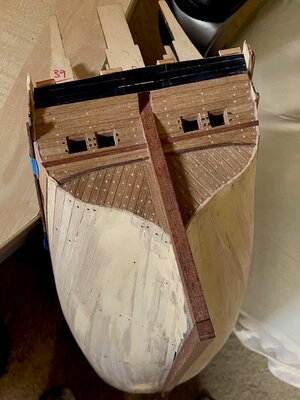
Yes –as we all are aware of the tucked stern controversy; some historians (a few) have questioned the rounded tuck –most have used Pett’s painting as “the” reference”. I chose to build a modified square tuck – right or wrong – In any case this current project will, however modified, not represent amazing much more accurate scratch built examples. Given the still existing controversies, I won’t labor over my errors so far, and certainly those coming up. That said, here are some images so far.
As always thanks so much for dropping by.







Looks really good. That pear wood is awesome. I have to learn how to trenail like that. First is to fond some spare patience... I thought I left it around here somewhere...
I've just been scouring the internet and copying all the information and SotS build logs I can find, even the Italian and German ones, in preparation for my own build.@DARIVS ARCHITECTVS This is magnificent information Kurt. I wish I had such a great source for my builds!
I've just been scouring the internet and copying all the information and SotS build logs I can find, even the Italian and German ones, in preparation for my own build.
Remember to include that Chech site which has a critical look at the Sergal kit and also otherwise is full of good information.
János
If I listed all the sites from which I gathered information, the server would be FULL. I have trouble just going back through all the links trying to locate where I found a particular bit of information. The picture below was taken from http://militarynavalhistory.net/ but it is no longer available. It shows the deck locations before and after the rebuild of 1660.Remember to include that Chech site which has a critical look at the Sergal kit and also otherwise is full of good information.
János
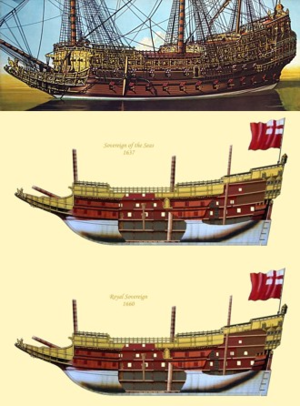
I printed the image earlier last year, and had to re-scan it to recover it. Here it is:
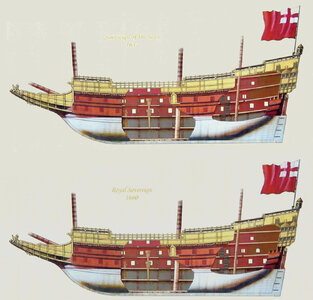
Last edited:





